Literacy Research Spotlight: A collation of recommendations from major adolescent literacy reports from the last 14 years
By Nicole Marie and Judy Douglas
You’ve collected a range of literacy data. You've analysed it, identified patterns, and discussed what this might mean with your colleagues. You’ve determined a goal, outcome or area for improvement. You’re committed to investigating and exploring changes in pedagogical practices to improve literacy outcomes. You’re passionate and excited about what lies ahead. You know your next step is to consult evidence-based research (the educational buzzword of the decade!) but you're not sure where to start or where to find relevant sources. You and your colleagues are asking 'What does the research say?' and 'Where do we find this research?'
In our roles as reflective practitioners and teacher-researchers who seek to learn more about teaching and learning, the question ‘What does the existing research say?” is a common one posed in the early stages of inquiry. Of course, as critical inquirers, we understand that ‘the research’ is never fully settled, one size does not fit all, and that it’s important to ask questions not just about what works, but “under what conditions”, for whom, and why (Wiliam, 2018).
Sometimes, knowing where to start with ‘the research out there’ (as distinct from conducting our own research in our classrooms or across our schools) can be daunting. One way to begin is to read major research reviews or analyses written for practitioners about the particular topic of inquiry. This is how we found ourselves rereading some major adolescent literacy reports, reviews and analyses from the last two decades, to see if we could find any patterns between their recommendations and suggested practices, or if we could observe any changes in these over time. To assist us in organising these resources to make it easier to revisit resources when we have a particular question or topic of inquiry, we collated our findings in a visual matrix that resembles a semantic feature grid; outlining some information about the selected sources, along with considerations to bear in mind when viewing these tables.
We think this could serve as a useful conversation-starter amongst secondary educators to support:
Building knowledge around effective literacy practices
Research-informed professional conversations
Evaluations of teaching and learning practices across a college
Inquiries conducted by literacy teams or PLCs
...with lots of questions to consider regarding context, students and implications for practice.
Our selections:
We chose our sources based on the following criteria:
Their recommendations and practice suggestions needed to draw upon the results of multiple peer-reviewed studies into adolescent literacy or literacy in secondary schools: As a result, our selection includes meta-analyses, guidance reports, systematic reviews, practice briefs and position statements that are informed by a range of peer-reviewed studies
The sources themselves needed to be major publications released in the last twenty years
The recommendations and suggestions needed to be relevant to practitioners working with adolescents —in other words, applicable to students engaging in secondary schooling of some kind (Eg: studies focusing solely on primary school students or on early literacy were excluded).
The recommendations and suggestions needed to be related to instruction and classroom practices
For a statement to ‘count’ as a recommendation or suggested practice in our tables, direct reference or precise descriptions to a particular approach needed to be made either in the form of a formal recommendation, an implementation guideline or an elaboration upon a recommendation made.
Before viewing, here are some considerations to bear in mind:
We are not scientists: Our collation was not highly systematic or scientific— we merely aimed to develop a visual overview of recommendations and practice suggestions drawn from major adolescent literacy reports, in order to notice patterns and start conversations.
The research papers we included are not an exhaustive list: Enough said!
Read with a discerning eye: Research is never settled or definite; it is a constant work-in-progress and is contestable. One thing it can provide us with in this case is a broad indication of practices that have been observed to be effective in improving adolescent literacy across multiple studies. Note our emphasis on the word ‘broad’ — these findings do not provide us with information about how contextual factors like environmental, student and implementation variables impact the results.
Also, these tables just show the frequency of recommendations across a range of reports with slightly different focuses. As a result, practices like explicit vocabulary instruction or targeted literacy interventions for struggling students do not seem to appear as often as others, yet they have been shown to have a high impact (Quigley, 2019). So please bear this in mind if you notice some practices do not appear as frequently as others. Note that just because a practice does not appear as frequently as others, it does not necessarily mean it is less effective.
Be aware of what tables like this DON’T tell us: These tables list a series of practices in isolation and the frequency in which they appear as recommendations or suggested practices across a series of reports. They do not tell us:
What combination of practices is most effective for particular groups of students
How particular practices might work together in nuanced ways within particular classrooms, or how they might be used to target the needs of particular students
How much time to spend on the practices
In other words, these tables focus on the what, not so much the how, when and why. That’s up to you, based on what you know about your students!
Go back to the sources and question everything: After viewing the tables it might be useful to click on the links of particular sources in our reference list below, and take a closer look. Click here for a list of questions recommended by AITSL, to be used when interrogating educational research.
Our tables displaying the collated research (click on the arrows to navigate):
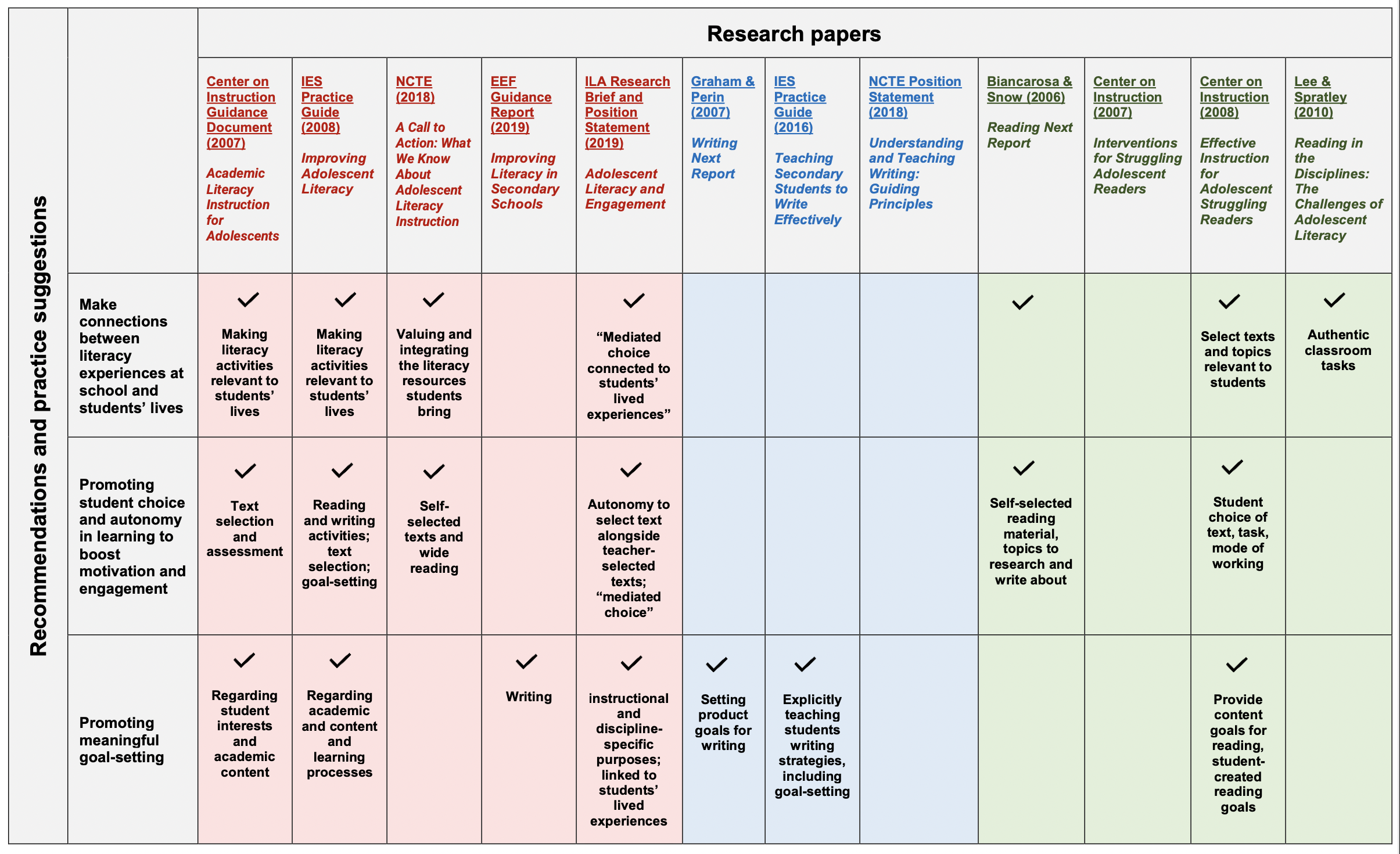
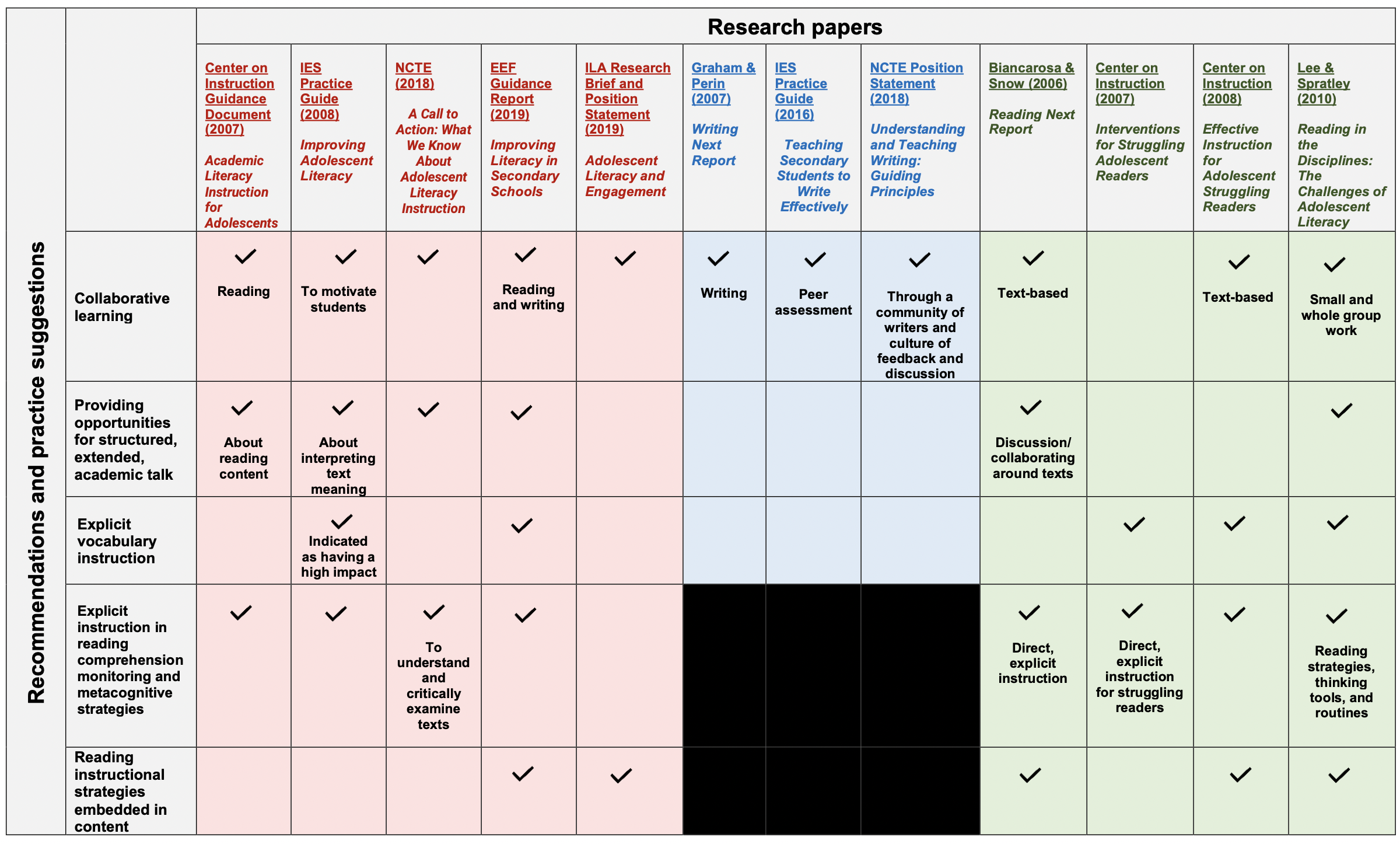
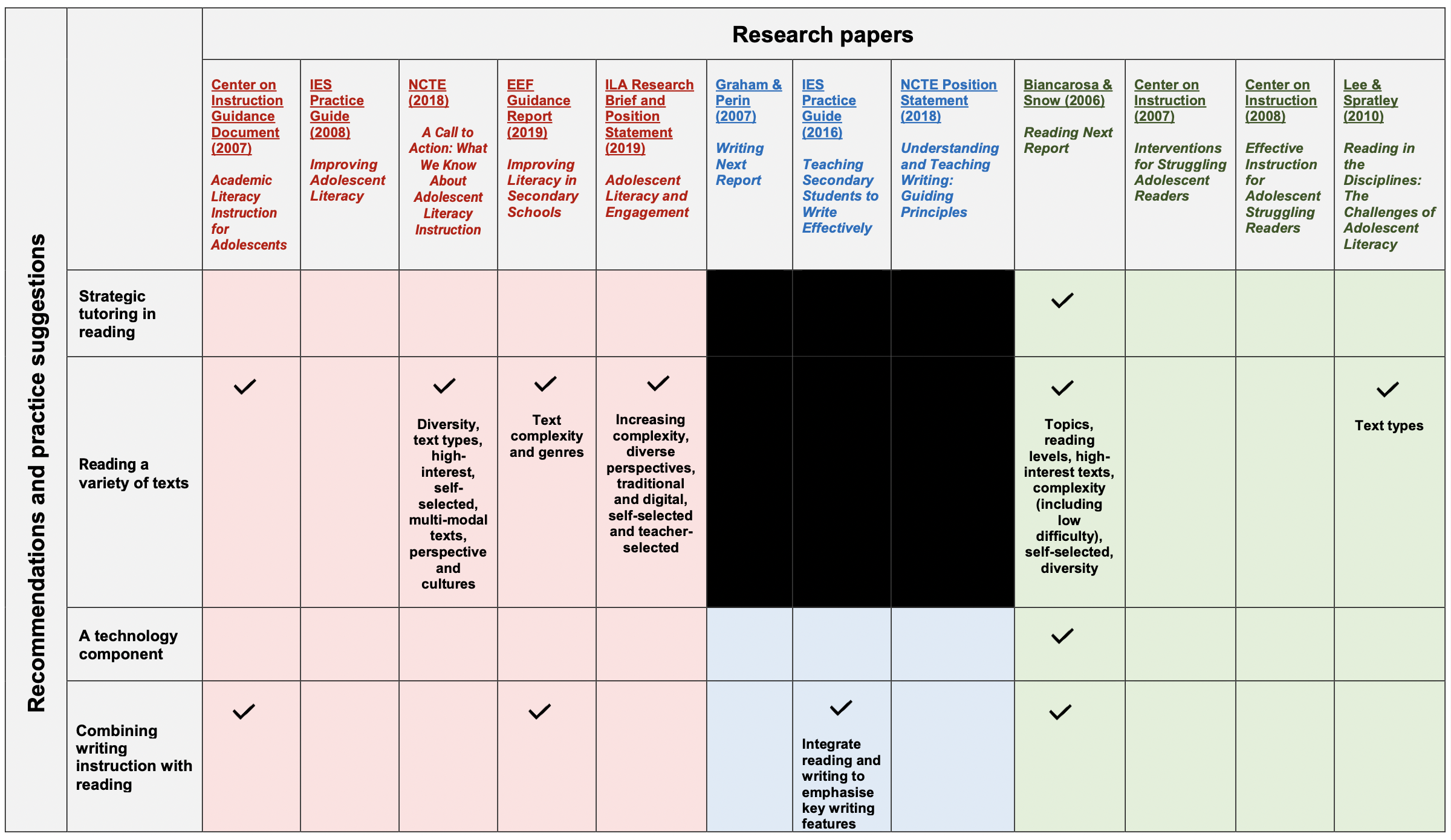
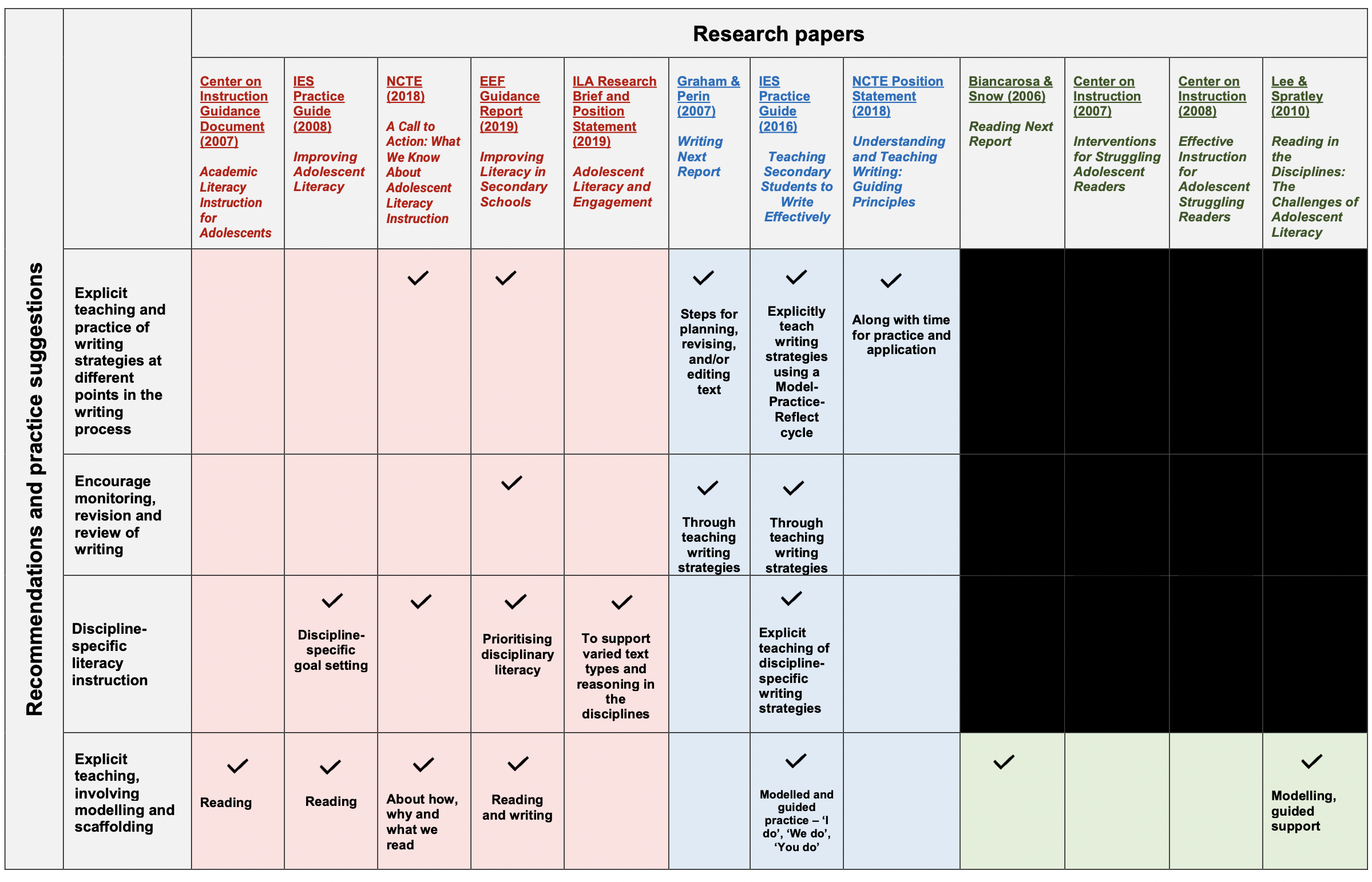
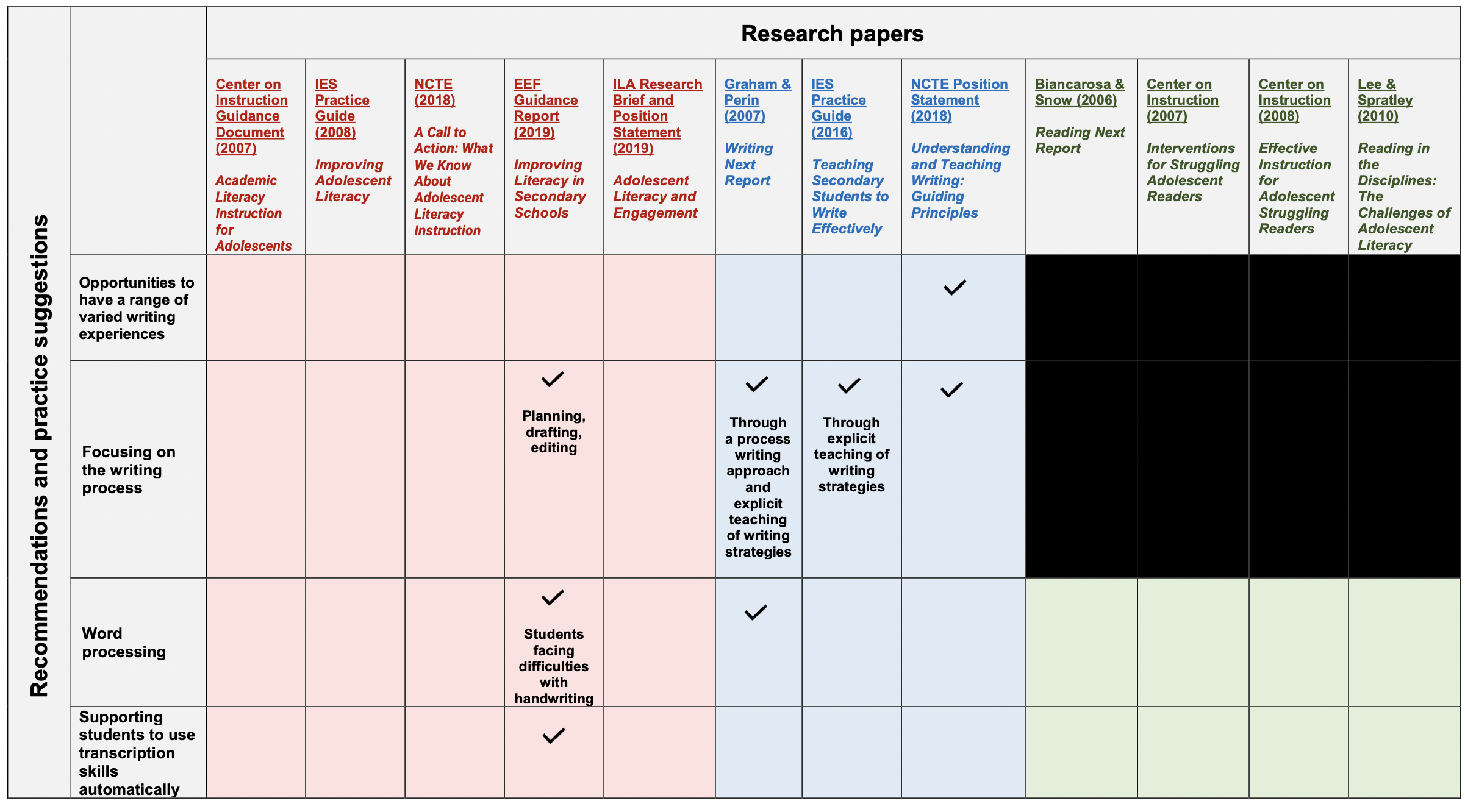
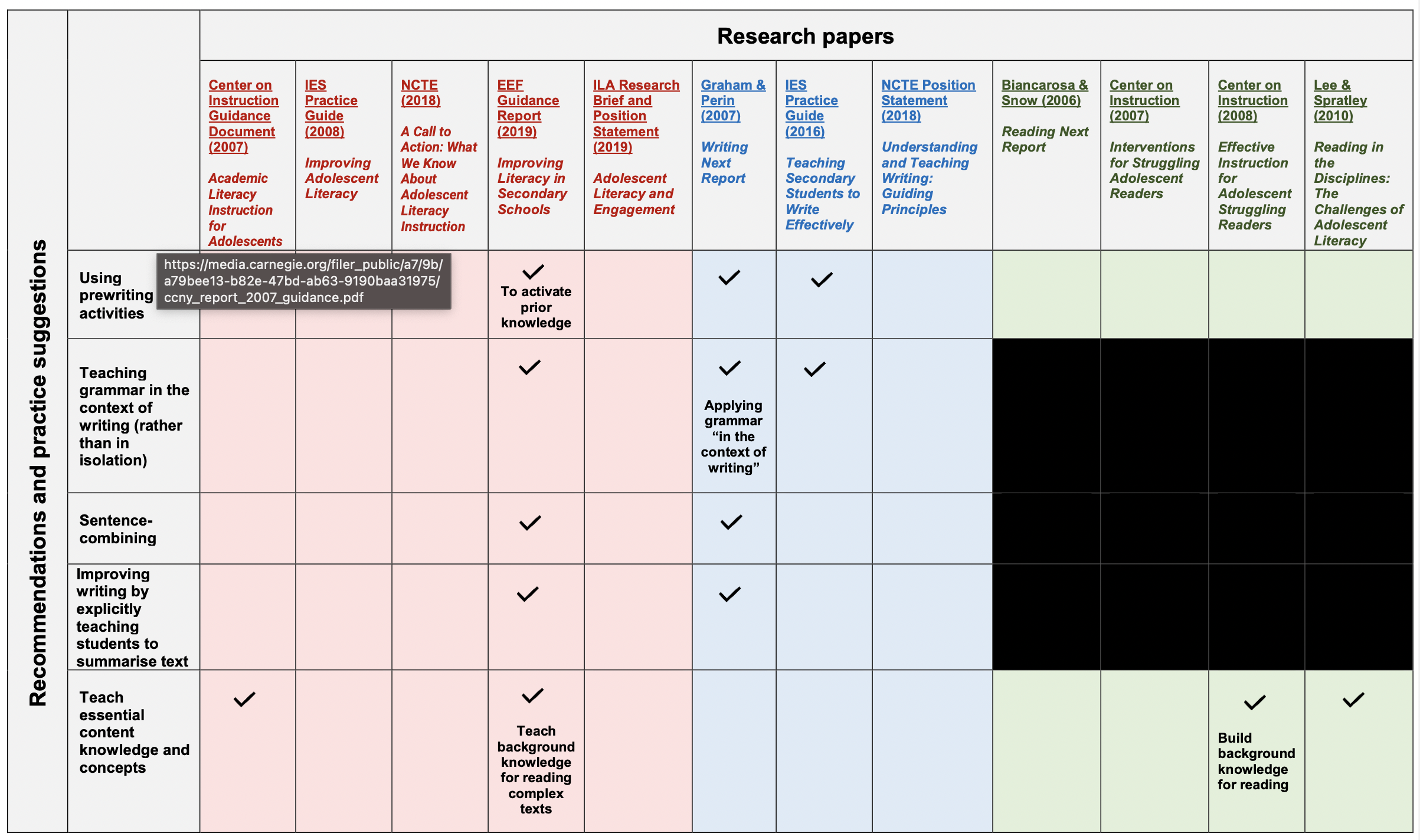

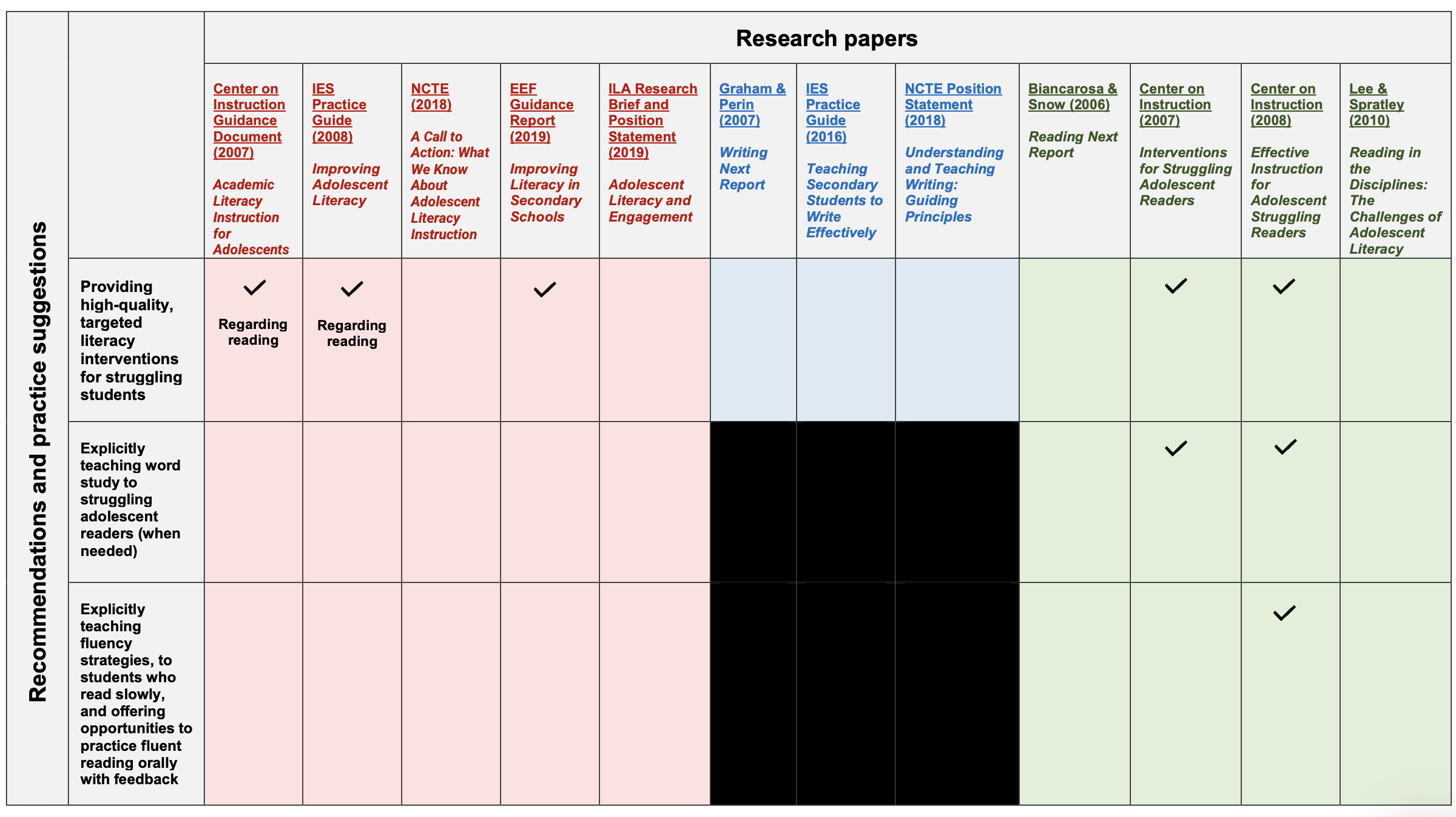
If you would like to access a free PDF copy of the tables featured in this post with hyperlinks, subscribe to our page below.
References:
Adler-Kassner, L., Baca, I., Fredricksen, J. (2018). Understanding and Teaching Writing: Guiding Principles. NCTE Working Committee, retrieved from: https://ncte.org/statement/teachingcomposition/
Biancarosa, C., & Snow, C. E. (2006). Reading next—A Vision for Action and Research in Middle and High School Literacy: A Report to Carnegie Corporation of New York (2nd ed.).Washington, DC: Alliance for Excellent Education. Retrieved from: https://media.carnegie.org/filer_public/b7/5f/b75fba81-16cb-422d-ab59-373a6a07eb74/ccny_report_2004_reading.pdf
Boardman, A. G., Roberts, G., Vaughn, S., Wexler, J., Murray, C. S., & Kosanovich, M. (2008). Effective Instruction for Adolescent Struggling Readers: A Practice Brief. Portsmouth, NH: RMC Research Corporation, Center on Instruction. Retrieved from: https://files.eric.ed.gov/fulltext/ED521836.pdf
Graham, S., & Perin, D. (2007). Writing Next: Effective Strategies to Improve Writing of Adolescents in Middle and High Schools –A Report to Carnegie Corporation of New York. Washington, DC: Alliance for Excellent Education. Retrieved from: https://media.carnegie.org/filer_public/b7/5f/b75fba81-16cb-422d-ab59-373a6a07eb74/ccny_report_2004_reading.pdf
Graham, S., Bruch, J., Fitzgerald, J., Friedrich, L., Furgeson, J., Greene, K., Kim, J., Lyskawa, J., Olson, C.B., & Smither Wulsin, C. (2016). Teaching Secondary Students to Write Effectively. Washington, DC: National Center for Education Evaluation and Regional Assistance, Institute of Education Sciences, U.S. Department of Education. Retrieved from: https://ies.ed.gov/ncee/wwc/Docs/PracticeGuide/508_WWCPG_SecondaryWriting_122719.pdf
International Literacy Association (2019), Research Brief and Position Statement: Adolescent Literacy and Engagement https://www.literacyworldwide.org/docs/default-source/where-we-stand/ila-engagement-and-adolescent-literacy.pdf
Kamil, M. L., Borman, G. D., Dole, J., Kral, C. C., Salinger, T., and Torgesen, J. (2008). Improving Adolescent Literacy: Effective Classroom and Intervention Practices: A Practice Guide. Washington, DC: National Center for Education Evaluation and Regional Assistance, Institute of Education Sciences, U.S. Department of Education. Retrieved from http://ies.ed.gov/ncee/wwc.
Lee, C.D., Spratley, A. (2010). Reading in the Disciplines: The Challenges of Adolescent Literacy. New York, NY: Carnegie Corporation of New York. Retrieved from: https://media.carnegie.org/filer_public/88/05/880559fd-afb1-49ad-af0e-e10c8a94d366/ccny_report_2010_tta_lee.pdf
Quigley, A. & Coleman, R. (2019), Improving literacy in secondary schools : Guidance Report, Education Endowment Foundation. Retrieved from: https://educationendowmentfoundation.org.uk/public/files/Publications/Literacy/EEF_KS3_KS4_LITERACY_GUIDANCE.pdf
Rehbein, T., Tovani, C., Skillen, M., Minor, C. (2018). NCTE Position Statement: A Call to Action: What We Know About Adolescent Literacy Instruction, NCTE Commission on Reading, retrieved from: https://ncte.org/statement/adolescentliteracy/
Scammacca, N., Roberts, G., Vaughn. S., Edmonds, M., Wexler, J., Reutebuch, C. K., & Torgesen, J. K. (2007), Interventions for Adolescent Struggling Readers: A Meta-Analysis with Implications for Practice. Portsmouth, NH: RMC Research Corporation, Center on Instruction. Retrieved from: https://files.eric.ed.gov/fulltext/ED521837.pdf
Torgesen, J. K., Houston, D. D., Rissman, L. M., Decker, S. M., Roberts, G., Vaughn, S., Wexler, J. Francis, D. J, Rivera, M. O., Lesaux, N. (2007). Academic Literacy Instruction for Adolescents: A Guidance Document from the Center on Instruction. Portsmouth, NH: RMC Research Corporation, Center on Instruction. Retrieved from: https://www.carnegie.org/publications/academic-literacy-instruction-for-adolescents-a-guidance-document-from-the-center-for-instruction
Wiliam, D. (2018). Creating the Schools Our Children Need. Learning Sciences International, West Palm Beach, FL.